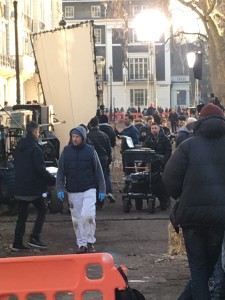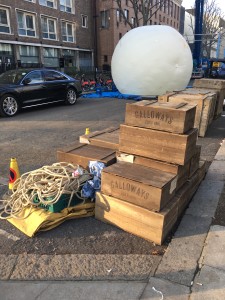[Note: this post has been edited to remove details of the specific production in question. I’m being cautious as a colleague reminded me of a non-disclosure agreement to which I am indirectly a party. However I have decided not to remove the entire post, since the rest pertains to observations made in outdoor public space, available to many other passersby besides me.]
Today and for the rest of the December holidays me and my other colleagues in Birkbeck’s School of Arts have been ejected from our building. Okay, I should really put that more nicely. We’ve been notified quite politely that our offices will be unavailable. The reason being that the buildings in which my School is based – 43 Gordon Street and adjacent buildings, and the street area outside – are being used for film shoot. [Specific detail on film production removed.]
So I’m ensconced fairly happily in the nearby Senate House Library. I’m meant to be focusing on tying up the writing of a special issue introduction, alongside revisions to a separate book chapter, both in collaboration with Helen Morgan Parmett, and both on theorizing/studying media production spaces. But curiosity of what I might find around the corner, and its obvious resonance with what I’m supposed to be working on, soon overtook me, and I went to take a look.
Some photos I took are below. I was stunned to see my normal workplace quite dramatically converted to a media production space. Now, maybe it’s just that I don’t normally witness film shoots for such big budget productions. But the sheer scale of the impact on the area was unexpected. Surrounding streets were chock-a-block with film vehicles and police cordons. And Gordon Square itself was rendered Victorian, vaguely, not just by a slew of extras wearing period attire, but by changes made to the buildings themselves (both exterior and interior), and the laying of dirt and leaves over the street pavement. I have no idea what sort of post-production work will be done to, for example, erase the modernist towers of nearby Euston Station. But even all these extras filling the changed street was striking in itself. Framing one’s visibility appropriately, you could almost partake in sort of vicarious time travel.
One of the points Helen and I make in a chapter we are writing for the forthcoming edited book Geomedia Studies is that the spatialities of contemporary media production practices are increasingly fissive, momentary and mobile. In other words, media production – such as the big-budget, on-location filming I saw today – increasingly involves forms of temporary place-making. That is, momentarily bounding space in certain ways, through the appearance of unambiguously media-oriented practices, and associated bodies, materials and technologies. That said, as much as this appears as a jarring imposition of media rationalities onto this local corner of Bloomsbury (e.g. I saw several people arrive at the cordons only to realize they couldn’t access one building or another) the grounds for this conversion into a media production space were readied by localized conditions on the ground. [Details of specific production removed.]
But enough rambling already. It’s time to get back to that other writing. As an aside, if you are interested in the buildings being used for this film shoot, some of my colleagues in the School recently produced a short film exploring the interesting history of these once-residential buildings.
Photos (click to enlarge):








0 Comments Leave a comment